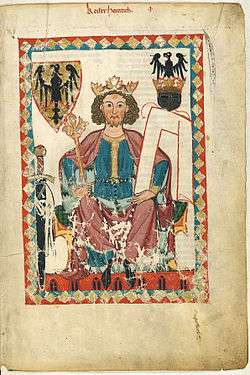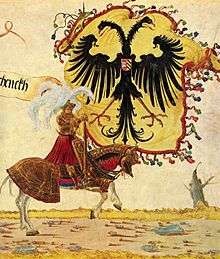Reichsadler
Part of a series on the |
||||||||||
|---|---|---|---|---|---|---|---|---|---|---|
| History of Germany | ||||||||||
 | ||||||||||
| Topics | ||||||||||
| Early history | ||||||||||
| Middle Ages | ||||||||||
| Early Modern period | ||||||||||
| Unification | ||||||||||
| German Reich | ||||||||||
|
||||||||||
| Contemporary Germany | ||||||||||
|
||||||||||
|
| ||||||||||
The Reichsadler ("Imperial Eagle") is the heraldic eagle, derived from the Roman eagle standard, used by the Holy Roman Emperors and in modern coats of arms of Germany, including those of the Second German Empire (1871–1918), the Weimar Republic (1919–1933) and the Third Reich (Nazi Germany, 1933–1945).
The same design has remained in use by the Federal Republic of Germany since 1945, albeit under the name Bundesadler ("Federal Eagle").
History
Medieval use
The Reichsadler can be traced back to the banner of the Holy Roman Empire, when the eagle was the insignia of Imperial power as distinguished from the Imperial states. It was meant to embody the reference to the Roman tradition (translatio imperii), similar to the double-headed eagle used by the Palaiologi emperors of the Byzantine Empire or the tsars of Russia (see coat of arms of Russia).
A double-headed eagle was attributed to Frederick II of Hohenstaufen in the Chronica Majora by Matthew Paris about 1250, and also appeared on the seal of the Imperial city of Kaiserswerth in the 13th century. The Reichsadler was widely used by Imperial cities such as Lübeck, Besançon and Cheb to underline their Imperial immediacy. The Teutonic Order under Hermann von Salza had the privilege to display the Imperial eagle in their coat of arms, granted by Emperor Frederick II. The black eagle was later adopted when the Teutonic State was transformed into the Duchy of Prussia in 1525, and a modified version was used in the arms of Royal Prussia (1466–1772). The ducal arms later formed the basis of the arms of the Kingdom of Prussia and its successor the Free State of Prussia until it was formally abolished in 1947. (See: Coat of arms of Prussia.)
Sigismund of Luxembourg used a black double-headed eagle after he was crowned Emperor in 1433. From this time, the single-headed Reichsadler represented the title of King of the Romans, and the double-headed one the title of Emperor. Over the following century, Albert II of Germany was the last King-elect of Germany who did not go on to be crowned emperor. After the German Reformation, beginning with Ferdinand I (1558), emperors were no longer crowned by the pope.
In 1804, Holy Roman Emperor Francis II established the Austrian Empire from the lands of the Habsburg Monarchy, and adopted the double-headed eagle, aggrandized by an inescutcheon emblem of the House of Habsburg-Lorraine and the Order of the Golden Fleece, as its coat of arms; the Holy Roman Empire was subsequently dissolved in 1806. Since 1919 the coat of arms of Austria has depicted a single-headed eagle. Although not a national symbol in the modern sense, the Reichsadler evoked sentiments of loyalty to the empire.[1]
Modern use
Following the revolutions of 1848 in the German states, the Reichsadler was restored as a symbol of national unity: it became the coat of arms of the short-lived German Empire and subsequently the German Confederation from its restoration in 1850 until its dissolution in 1866. It was once again restored in 1871 when a single-headed eagle with a Prussian inescutcheon became the insignia of the German Empire; the single head was used to represent the so-called Kleindeutschland, i.e. it excluded Austria. After World War I the Weimar Republic under President Friedrich Ebert assumed a plain version of the Reichsadler, which remained in use until 1935.
During Nazi rule, a stylised eagle combined with the Nazi Hakenkreuz was made the national emblem (Hoheitszeichen) by order of Adolf Hitler in 1935. Despite its medieval origin, the term "Reichsadler" in common English understanding is mostly associated with this specific Nazi era version. The Nazi Party had used a very similar symbol for itself, called the Parteiadler ("Party's eagle"). These two insignia can be distinguished as the Reichsadler looks to its right shoulder whereas the Parteiadler looks to its left shoulder.
After World War II the Federal Republic of Germany re-implemented the eagle used by the Weimar Republic by enactment of President Theodor Heuss in 1950.
Gallery
 Seal of Conrad II (1029), with a depiction of the eagle-sceptre.
Seal of Conrad II (1029), with a depiction of the eagle-sceptre..svg.png) Royal coat of arms of the Hohenstaufen emperors (1155–1197), after its appearance in Codex Manesse (c. 1304) with Henry VI (r. 1169–1197).
Royal coat of arms of the Hohenstaufen emperors (1155–1197), after its appearance in Codex Manesse (c. 1304) with Henry VI (r. 1169–1197).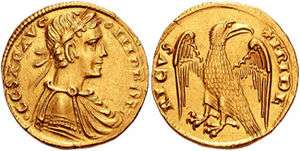 Imperial eagle on a coin of Frederick II (r. 1197–1250)
Imperial eagle on a coin of Frederick II (r. 1197–1250)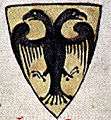 13th-century depiction of the arms of Otto IV (early depiction of a double-headed Reichsadler)
13th-century depiction of the arms of Otto IV (early depiction of a double-headed Reichsadler) Coat of arms of Emperor Sigismund of Luxembourg in 1433
Coat of arms of Emperor Sigismund of Luxembourg in 1433
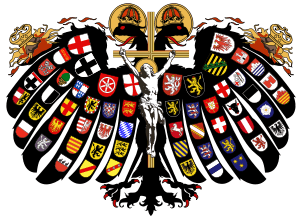
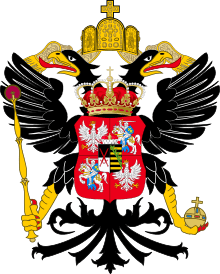 Coat of arms of Augustus III of Poland (r. 1734–1763), as Prince-Elector of Saxony being the Vicar of the Holy Roman Empire
Coat of arms of Augustus III of Poland (r. 1734–1763), as Prince-Elector of Saxony being the Vicar of the Holy Roman Empire.svg.png) Coat of arms of the short-lived German Empire 1848/49; the German Confederation used a similar eagle.
Coat of arms of the short-lived German Empire 1848/49; the German Confederation used a similar eagle..svg.png) Coat of arms of the Austrian Empire (1804–1867); also used as the lesser arms of Austria-Hungary (1867–1915).
Coat of arms of the Austrian Empire (1804–1867); also used as the lesser arms of Austria-Hungary (1867–1915).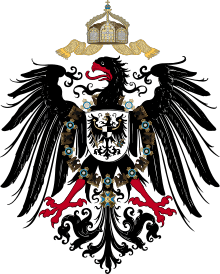 Reichsadler (official design 1888–1918) of the (Second) German Empire
Reichsadler (official design 1888–1918) of the (Second) German Empire.svg.png) Reichsadler (1919–1927) of the Weimar Republic
Reichsadler (1919–1927) of the Weimar Republic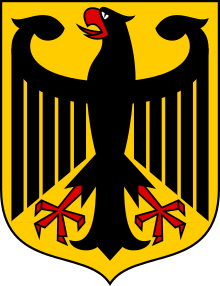 "Reichsadler" Coat of arms of the Weimar Republic (1928–1935)
"Reichsadler" Coat of arms of the Weimar Republic (1928–1935).svg.png) Parteiadler of the Nazi Party (1933–1945)
Parteiadler of the Nazi Party (1933–1945)_(andere).svg.png) Parteiadler of the Nazi Party (1933–1945) variant
Parteiadler of the Nazi Party (1933–1945) variant.svg.png) Reichsadler (1935–1945) of Nazi Germany
Reichsadler (1935–1945) of Nazi Germany.svg.png)
 "Bundesadler" of the Federal Republic of Germany since 1949
"Bundesadler" of the Federal Republic of Germany since 1949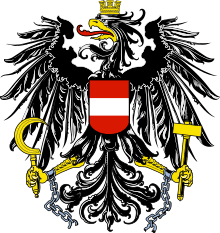 "Bundesadler" of the Republic of Austria since 1945; the same design, without the broken chains symbolizing the end of fascism, was used 1919–1934
"Bundesadler" of the Republic of Austria since 1945; the same design, without the broken chains symbolizing the end of fascism, was used 1919–1934
See also
References
- ↑ Selzer, Stephan. Deutsche Söldner im Italien des Trecento. Niemeyer: Tübingen, 2001. Page 167.
- Norbert Weyss: "Der Doppeladler – Geschichte eines Symbols", Adler 3, 1986, 78ff.
- Franz Gall: "Zur Entwicklung des Doppeladlers auf den kaiserlichen Siegeln", Adler 8 (1970), 281ff.
- Vladimir Monakhov: Новые-старые цвета России, или Как возвращали орла, ГЕРАЛЬДИКА СЕГОДНЯ (2003).
- Michael Göbl, "Staatssymbole des Habsburger-Reiches - ab 1867 mit besonderer Berücksichtigung des Staatswappens", in: Österreichs politische Symbole (1994), 11ff.
External links
| Wikimedia Commons has media related to Reichsadler. |
- P. Diem, Die Entwicklung des österreichischen Doppeladlers (in German)
